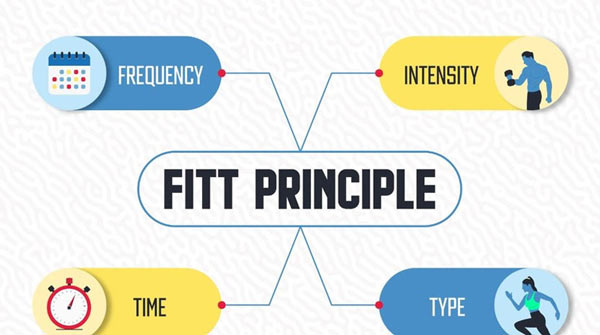The FITT Principle encapsulates Frequency, Intensity, Time, and Type. It emerges as a pivotal guide in the pursuit of a healthier lifestyle. It offers an effective framework for tailoring workouts. This methodology shapes our understanding. Through careful consideration of these four components, we can optimize our fitness routine.
Introduction to the FITT Principle
To comprehend the FITT Principle, you must delve into the nuances of its elements. Frequency, Intensity, Time, and Type, these components collectively foster a holistic approach to fitness training, a method that accommodates individual needs and objectives.
Frequency - Determining Optimal Engagement
Establishing a balanced workout routine that fosters consistency and gradual adaptation, regardless of your fitness level, relies on the pivotal factor of frequency. You must find the optimal equilibrium. This is where success lies. It prevents burnout while ensuring sustained progress.
Choosing the Right Workout Frequency:
To determine the optimal workout frequency, you must thoughtfully consider individual factors. Evaluate your fitness level, a process that accounts for both physical capabilities and limitations. Simultaneously, factor in personal commitments such as work, family, and social obligations.
Aligning with your lifestyle, a tailored approach not only prevents overexertion but also establishes the stage for long-term success.
Adapting Frequency for Different Goals:
The FITT Principle is a concept that is not one-size-fits-all. Rather, it adapts to diverse objectives. If your objective is weight loss, muscle gain, or cardiovascular health, understanding the influence of frequency on each goal becomes paramount.
Reflecting the specific demands of your objectives, tailor your workout schedule and harmoniously align your desired outcomes with appropriate frequency.
Intensity - Customizing Effort for Progress
Your workouts' intensity measures the level of difficulty or exertion, striking with paramount importance the right balance. Too much or too little are extremes that can impede progress. To achieve sustained improvement, tailor your intensity to your current fitness level and leverage periodization techniques. They are instrumental in this pursuit.
Customizing Intensity for Your Fitness Level:
It is not a one-time adjustment, but rather an ongoing process to adapt intensity to your fitness level. You must tailor your workouts. They should challenge your capabilities without posing any risks of injury or burnout.
By ensuring gradual progression, and laying the foundation for sustained and effective results, your body will continually adapt. This is crucial in graduate-level fitness training.
Periodization Techniques for Intensity:
Incorporating periodization, a strategic tool involving the deliberate variation of workout intensity over time, prevents plateaus. It also fosters continuous improvement and minimizes overtraining risks.
This approach allows for a dynamic and adaptive fitness routine that metamorphoses along your journey.
Time - Maximizing Efficiency
Understanding optimal time frames for different workouts like high-intensity interval training (HIIT) strategies and embracing efficient approaches are critical. They enable you to maximize the duration of your workouts, playing a crucial role in achieving fitness goals.
The Sweet Spot for Workout Duration:
Balancing effectiveness and sustainability involves discovering the ideal time frame for various workouts. Ensure your workout duration aligns with your objectives, accommodating your schedule at the same time.
By finding this 'sweet spot,' you foster consistency, a key factor in long-term adherence.
Efficiency in Short Workouts:
Those with busy schedules experience a game-changing advantage when they leverage time-efficient strategies such as HIIT. Within a condensed timeframe, shorter yet intense workouts yield significant results. Maximize efficiency without compromising effectiveness by mastering the structure and execution of these sessions.

Type - Crafting a Well-Rounded Routine
Your workouts derive significant benefits from the type of exercise you engage in. A comprehensive and well-rounded approach results when you diversify your routine to target different muscle groups, aligning the types of exercises with your specific fitness goals.
Diversifying Your Workout Routine:
Essential for targeting different muscle groups and preventing monotony is the incorporation of a variety of exercises. To foster a holistic and engaging fitness routine, explore various forms, of cardiovascular training, and strength training, including weightlifting, resistance work, or bodyweight exercises as well as flexibility regimes like yoga or Pilates.
Tailoring Exercise Type to Your Goals:
The FITT Principle guides a strategic approach. It aligns exercise types with your unique fitness aspirations. If you aim to build muscle, enhance endurance, or improve flexibility, tailor each workout. In doing so, it ensures that every session meaningfully contributes towards the achievement of your overarching objectives.
Effective Workouts and the FITT Principle - Crafting a Personalized Approach
By synthesizing the FITT components, one can create a personalized and effective workout plan that aligns with their goals. The integration and adaptation of these elements provide practical tips to maintain an ever-evolving fitness routine in response to changing levels of fitness and objectives.
Creating Your FITT-Optimized Workout Plan:
Design a customized workout plan by leveraging the FITT Principle. This applies whether you are modifying an existing routine or creating one from scratch. Ensure a cohesive, goal-oriented approach to structuring your workouts in alignment with the FITT components. Understand it and execute it masterfully.
Monitoring and Adjusting:
You must regularly assess your workout plan. This is essential for adjusting as your fitness level improves, or when goals change. Learning to be proactive in adapting, ensuring continued progress, and preventing stagnation, is crucial on the journey towards optimal fitness.
How to Make the Most Out of the FITT Principle?
- Set Clear Goals:
Define your fitness objectives clearly before you apply the FITT Principle, be it weight loss, muscle gain, or overall wellness. Specific goals, no matter their nature, will serve as your compass guiding adjustments in frequency, intensity, and time, all crucial components of achieving success through this principle.
- Know Your Baseline:
Evaluate your present fitness level. This step is crucial to establishing a starting point, one that guarantees your modifications remain realistic and in harmony with what you can accomplish.
- Be Consistent:
To see results, the key is consistency. Adhere steadfastly to your adjusted workout plan and resist the temptation of frequent parameter changes. Leave room for adaptation and progress. These are integral components in achieving optimal outcomes.
- Gradual Progression:
Gradually modify frequency, intensity, time, or type; avoid rapid adjustments that may precipitate burnout or injury. Your objective should be sustained progress over an extended period, prioritizing longevity and consistency in your efforts.
- Listen to Your Body:
Focus on your body's response to every adjustment. If you persistently experience fatigue, soreness, or discomfort, reassess your approach, then, implement necessary modifications.
- Periodize Effectively:
To prevent plateaus and induce a responsive state in your body to training stimuli, implement periodization strategies that vary in intensity. This can be achieved by orchestrating periods of both higher and lower intensity.
- Combine Workout Types:
Incorporate various types of exercises to embrace a well-rounded approach. Combine cardiovascular activities, integrate strength training, and include flexibility workouts. This strategy targets not only multiple muscle groups but also diverse energy systems.
- Prioritize Recovery:
Acknowledge the significance of rest and recovery. Indeed, adequate sleep, proper nutrition, and active recovery days are all factors that bolster your overall fitness gains.
- Seek Professional Guidance:

If you harbor uncertainties in applying the FITT Principle, it is advisable to consult a fitness professional. They are well-equipped to provide personalized guidance, tailored specifically for your unique circumstances and goals.
- Document Your Journey:
Maintain a workout journal, as this will enable you to meticulously track not only your adjustments but also the progress you make. Such documentation proves instrumental in comprehending what strategies best suit your body.
Furthermore, it forms an essential basis for future modifications, a tool that consistently informs and guides these necessary changes.
Conclusion
The FITT Principle is a beacon illuminating effective workouts and long-term fitness success. It hinges on the understanding and application of four key principles, namely Frequency, Intensity, Time, and Type.
By grasping these concepts, and then applying them to your routine, you unlock the door to a healthier lifestyle filled with more satisfaction. Embrace this versatile principle. Tailor it into an evolving workout regimen that initially meets current goals but can adapt as you progress further in your journey toward optimum health.




